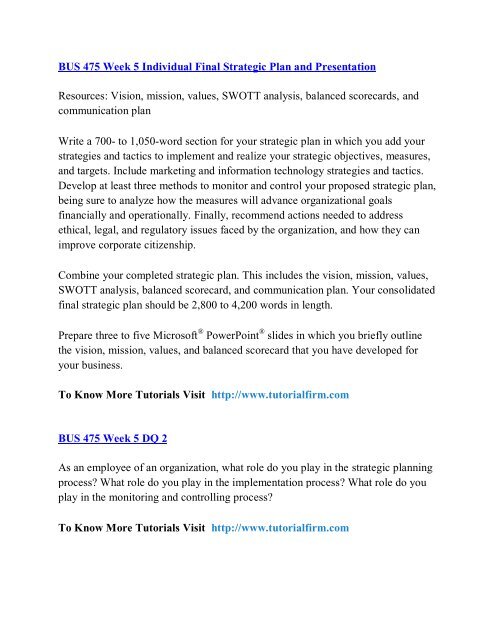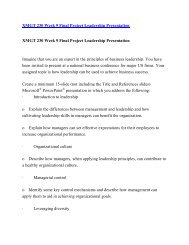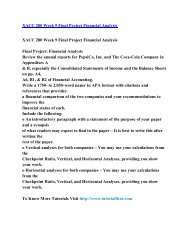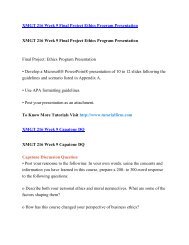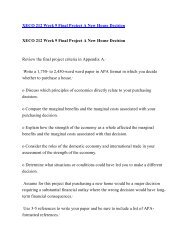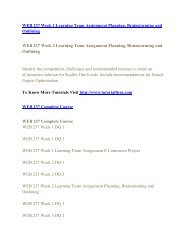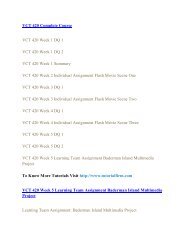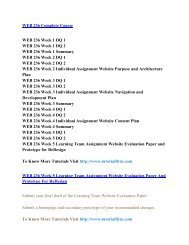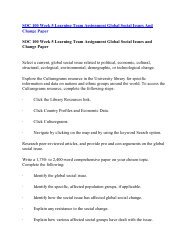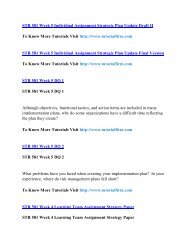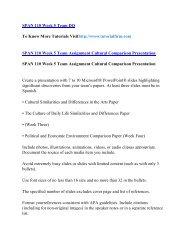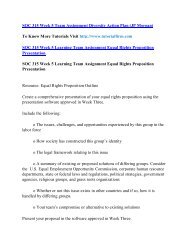BUS 475
Create successful ePaper yourself
Turn your PDF publications into a flip-book with our unique Google optimized e-Paper software.
<strong>BUS</strong> <strong>475</strong> Week 5 Individual Final Strategic Plan and Presentation<br />
Resources: Vision, mission, values, SWOTT analysis, balanced scorecards, and<br />
communication plan<br />
Write a 700- to 1,050-word section for your strategic plan in which you add your<br />
strategies and tactics to implement and realize your strategic objectives, measures,<br />
and targets. Include marketing and information technology strategies and tactics.<br />
Develop at least three methods to monitor and control your proposed strategic plan,<br />
being sure to analyze how the measures will advance organizational goals<br />
financially and operationally. Finally, recommend actions needed to address<br />
ethical, legal, and regulatory issues faced by the organization, and how they can<br />
improve corporate citizenship.<br />
Combine your completed strategic plan. This includes the vision, mission, values,<br />
SWOTT analysis, balanced scorecard, and communication plan. Your consolidated<br />
final strategic plan should be 2,800 to 4,200 words in length.<br />
Prepare three to five Microsoft ® PowerPoint ® slides in which you briefly outline<br />
the vision, mission, values, and balanced scorecard that you have developed for<br />
your business.<br />
To Know More Tutorials Visit http://www.tutorialfirm.com<br />
<strong>BUS</strong> <strong>475</strong> Week 5 DQ 2<br />
As an employee of an organization, what role do you play in the strategic planning<br />
process? What role do you play in the implementation process? What role do you<br />
play in the monitoring and controlling process?<br />
To Know More Tutorials Visit http://www.tutorialfirm.com
<strong>BUS</strong> <strong>475</strong> Week 5 DQ 1<br />
Why is it necessary to monitor and control strategic plans? Who should be<br />
responsible for monitoring and controlling strategic plans? Why? What are the<br />
pitfalls of failing to monitor and control strategic plans?<br />
To Know More Tutorials Visit http://www.tutorialfirm.com<br />
<strong>BUS</strong> <strong>475</strong> Week 4 Learning Team Communication Plan Outline<br />
Develop a generic communications plan and template. This template will be used<br />
to develop a communication plan for your Final Strategic Plan, due in Week Five.<br />
To Know More Tutorials Visit http://www.tutorialfirm.com<br />
<strong>BUS</strong> <strong>475</strong> Week 4 Individual Strategic Plan Part III Balanced Scorecard<br />
Resource: Exhibit 7-1 in Ch. 7 of Strategic Management<br />
Develop the strategic objectives for your business in the format of a balanced<br />
scorecard. The strategic objectives are measures of attaining your vision and<br />
mission. As you develop them consider the vision, mission, and values for your<br />
business and the outcomes of your SWOTT analysis. Consider the following four<br />
quadrants of the balanced scorecard when developing your strategic objectives:<br />
· Shareholder Value or Financial Perspective, includes strategic objectives in<br />
areas such as:<br />
o<br />
o<br />
o<br />
Market share<br />
Revenues and costs<br />
Profitability
o<br />
Competitive position<br />
· Customer Value Perspective, includes strategic objectives in areas such as:<br />
o<br />
o<br />
o<br />
Customer retention or turnover<br />
Customer satisfaction<br />
Customer value<br />
· Process or Internal Operations Perspective, includes strategic objectives in<br />
areas such as:<br />
o<br />
o<br />
o<br />
Measure of process performance<br />
Productivity or productivity improvement<br />
Operations metrics<br />
· Learning and Growth (Employee) Perspective, includes strategic objectives<br />
in areas such as:<br />
o<br />
o<br />
o<br />
o<br />
o<br />
Employee satisfaction<br />
Employee turnover or retention<br />
Level of organizational capability<br />
Nature of organizational culture or climate<br />
Technological innovation<br />
Develop at least two strategic objectives for each of the following four balanced<br />
scorecard areas identified above (Financial, Customer, Process, Learning and
Growth). Your objectives should be selected, in part, based on an evaluation of a<br />
number of potential alternatives to the issues and/or opportunities identified in the<br />
SWOTT Analysis paper and table you completed in Week Three. Base your<br />
solutions on a ranking of alternative solutions that includes an identification of<br />
potential risks and mitigation plans, and a stakeholder analysis that includes<br />
mitigation and contingency strategies. You should also incorporate the ethical<br />
implications of your solutions into your selection.<br />
For each strategic objective, develop a metric and target using a balanced scorecard<br />
format. (For example, a strategic objective in the shareholder or Financial<br />
Perspective is to increase market share. A metric to actually measure this strategic<br />
objective of market share increase is, “The percentage of increase in market<br />
share.” The target is the specific number to be achieved in a particular time period.<br />
The target for the metric of “Increase market share” could be “Increase market<br />
share by 2% for each of the next 3 years” of an increase of 2% per year for 3<br />
years.)<br />
Write a 700- to 1,050-word summary that explains your critical thinking on how<br />
you derived your objectives from your vision, mission, values, and SWOTT<br />
analysis.<br />
Format paper consistent with APA guidelines.<br />
To Know More Tutorials Visit http://www.tutorialfirm.com<br />
<strong>BUS</strong> <strong>475</strong> Week 4 DQ 2<br />
What things should be taken into consideration in the creation of a roadmap for a<br />
strategic plan? What are some examples of external and internal change agents?<br />
What role do change agents play in the execution of a road map for a strategic<br />
plan?<br />
To Know More Tutorials Visit http://www.tutorialfirm.com
<strong>BUS</strong> <strong>475</strong> Week 4 DQ 1<br />
Why is it important to continuously update the implementation and communication<br />
of a strategic plan? Who should be responsible for updating and communicating a<br />
strategic plan? Why?<br />
To Know More Tutorials Visit http://www.tutorialfirm.com<br />
<strong>BUS</strong> <strong>475</strong> Week 3 Learning Team Functional Area Interrelationships<br />
Select one organization of the Virtual Organizations from the student website.<br />
Write a 1,400- to 2,100-word paper in which you complete the following:<br />
State the primary reasons for the organization’s existence from an analysis of the<br />
mission, vision, values, and goals.<br />
Analyze the reason for the type of organizational structure employed by the<br />
organization, and identify the key positions that support that organizational<br />
structure.<br />
Identify and explain the steps of the collaboration process among the functional<br />
areas that must be employed to achieve organizational goals, and prepare an action<br />
plan to implement the collaboration process.<br />
Identify and provide an example of the use of lateral collaboration and vertical<br />
collaboration within the organization, and prepare an action plan to use lateral and<br />
vertical collaboration.<br />
Identify the key stakeholders and their roles needed to achieve the organizational<br />
goals, and recommend the collaborative interactions among the key stakeholders to<br />
facilitate the organization’s success.
To Know More Tutorials Visit http://www.tutorialfirm.com<br />
<strong>BUS</strong> <strong>475</strong> Week 3 Individual Strategic Plan Part II SWOTT Analysis<br />
Conduct an internal and external environmental analysis for your proposed<br />
business.<br />
Create a SWOTT table summarizing your findings. Your environmental analysis<br />
should take into account, at a minimum, the following factors. For each factor,<br />
identify the one primary strength, weakness, opportunity, threat, and trend, and<br />
include it in your table.<br />
· External forces and trends considerations:<br />
o<br />
o<br />
o<br />
o<br />
o<br />
o<br />
o<br />
o<br />
Legal and regulatory<br />
Global<br />
Economic<br />
Technological<br />
Innovation<br />
Social<br />
Environmental<br />
Competitive analysis<br />
· Internal forces and trends considerations:<br />
o<br />
Strategy
o<br />
o<br />
o<br />
o<br />
o<br />
o<br />
o<br />
o<br />
o<br />
o<br />
Structures<br />
Processes and systems<br />
Resources<br />
Goals<br />
Strategic capabilities<br />
Culture<br />
Technologies<br />
Innovations<br />
Intellectual property<br />
Leadership<br />
Write a 1,400- to 1,750-word synopsis in which you analyze at least seven of the<br />
forces and trends from the list above. Your analysis must include the following:<br />
· Include economic as well as legal and regulatory forces and trends.<br />
· Critique how well the organization adapts to change.<br />
· Analyze the supply chain operations of the organization.<br />
· Identify issues and/or opportunities:<br />
o Identify the major issues and/or opportunities that the company faces based on<br />
your analysis above.
o Generate a hypothesis surrounding each issue and research questions to use for<br />
conducting analysis.<br />
o Identify the circumstances surrounding each issue; classify the circumstances;<br />
attribute the importance of each classification; and test the accuracy of the<br />
importance for each classification.<br />
Format your paper consistent with APA guidelines.<br />
To Know More Tutorials Visit http://www.tutorialfirm.com<br />
<strong>BUS</strong> <strong>475</strong> Week 3 DQ 2<br />
What is the difference among strategic, long-term and short-term,<br />
objectives? What is the relationship between objectives and goals? What are some<br />
examples of this relationship?<br />
To Know More Tutorials Visit http://www.tutorialfirm.com<br />
<strong>BUS</strong> <strong>475</strong> Week 3 DQ 1<br />
What are strategic objectives? What is the purpose of strategic objectives? What<br />
makes an effective strategic objective? What are examples of strategic objectives<br />
for you organization or one with which you are familiar?<br />
To Know More Tutorials Visit http://www.tutorialfirm.com<br />
<strong>BUS</strong> <strong>475</strong> Week 2 Individual Value Alignment<br />
Discuss an existing organization with which you are familiar that is different than<br />
the one you used for the Conceptualizing a Business paper.
Write a 700- to 1,050-word paper in which you analyze the individual values and<br />
the organization’s values as reflected by the organization’s plans and actions.<br />
Include the following in your paper:<br />
Analyze the origin(s) and subsequent evolution of your personal and workplace<br />
values.<br />
Explain how your individual values drive your actions and behaviors, and analyze<br />
the alignment between your values and actions and behaviors.<br />
Analyze the degree of alignment between the organization’s stated values and the<br />
organization’s actual plans and actions.<br />
Explain the differences and analyze the degree of alignment between your values<br />
and the organization’s values as reflected by the organization’s plans and actions.<br />
Format your paper consistent with APA guidelines.<br />
To Know More Tutorials Visit http://www.tutorialfirm.com<br />
<strong>BUS</strong> <strong>475</strong> Week 2 Individual Strategic Plan,Part I Conceptualizing a Business<br />
Write a 1,050- to 1,400-word paper in which you explain the importance of your<br />
selected business’s vision, mission, and values in determining your strategic<br />
direction. Please do not write about an existing business. Create a new business<br />
and include the following:<br />
Define your business, products or services, and customers by developing a<br />
mission statement. Ensure that you are differentiating your product or service.<br />
Create a vision for this organization that clearly demonstrates your decision on<br />
what you want your business to become in the future.
Define your guiding principles or values for your selected business considering<br />
the topics of culture, social responsibility, and ethics.<br />
Analyze how the vision, mission, and values guide the organization’s strategic<br />
direction.<br />
Evaluate how the organization addresses customer needs and critique how they<br />
achieve competitive advantage.<br />
Format your paper consistent with APA guidelines.<br />
To Know More Tutorials Visit http://www.tutorialfirm.com<br />
<strong>BUS</strong> <strong>475</strong> Week 2 DQ 2<br />
What are the key planning factors for competitive success? Provide an example of<br />
an organization that has achieved competitive success through planning (please do<br />
not use Wal-Mart). Provide an example of an organization that has failed to<br />
achieve competitive success as the result of failed planning<br />
To Know More Tutorials Visit http://www.tutorialfirm.com<br />
<strong>BUS</strong> <strong>475</strong> Week 2 DQ 1<br />
What is a SWOTT Analysis? What is its purpose in strategic planning? Must you<br />
conduct a SWOTT Analysis to have an effective strategic plan? Why or why not?<br />
To Know More Tutorials Visit http://www.tutorialfirm.com<br />
<strong>BUS</strong> <strong>475</strong> Week 1 DQ 2<br />
Select a small business that you may want to start and why you selected the<br />
business
(The business you select should be the business you plan to write about in this<br />
course). After answering this question, please answer the following questions:<br />
What is strategic management?<br />
Why is strategic management important to the success of the business you<br />
selected?<br />
How are the four functions of management relative to creating and implementing a<br />
strategic plan?<br />
To Know More Tutorials Visit http://www.tutorialfirm.com<br />
<strong>BUS</strong> <strong>475</strong> Week 1 DQ 1<br />
What is strategic management? What are the roles of mission and vision statements<br />
in strategic management? Can an organization have a successful strategic plan<br />
without effective mission and vision statements? Why or why not?<br />
To Know More Tutorials Visit http://www.tutorialfirm.com<br />
<strong>BUS</strong> <strong>475</strong> Complete Course<br />
<strong>BUS</strong> <strong>475</strong> Week 1 DQ 1<br />
<strong>BUS</strong> <strong>475</strong> Week 1 DQ 2<br />
<strong>BUS</strong> <strong>475</strong> Week 2 DQ 1<br />
<strong>BUS</strong> <strong>475</strong> Week 2 DQ 2<br />
<strong>BUS</strong> <strong>475</strong> Week 2 Individual Strategic Plan,Part I Conceptualizing a Business
<strong>BUS</strong> <strong>475</strong> Week 2 Individual Value Alignment<br />
<strong>BUS</strong> <strong>475</strong> Week 3 DQ 1<br />
<strong>BUS</strong> <strong>475</strong> Week 3 DQ 2<br />
<strong>BUS</strong> <strong>475</strong> Week 3 Individual Strategic Plan Part II SWOTT Analysis<br />
<strong>BUS</strong> <strong>475</strong> Week 3 Learning Team Functional Area Interrelationships<br />
<strong>BUS</strong> <strong>475</strong> Week 4 DQ 1<br />
<strong>BUS</strong> <strong>475</strong> Week 4 DQ 2<br />
<strong>BUS</strong> <strong>475</strong> Week 4 Individual Strategic Plan Part III Balanced Scorecard<br />
<strong>BUS</strong> <strong>475</strong> Week 4 Learning Team Communication Plan Outline<br />
<strong>BUS</strong> <strong>475</strong> Week 5 DQ 1<br />
<strong>BUS</strong> <strong>475</strong> Week 5 DQ 2<br />
<strong>BUS</strong> <strong>475</strong> Week 5 Individual Final Strategic Plan and Presentation<br />
To Know More Tutorials Visit http://www.tutorialfirm.com


